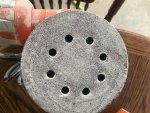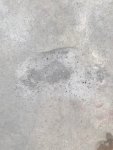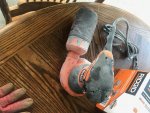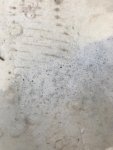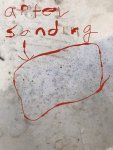It was a nice coincidence that I happened to be traveling through Los Angeles at this time. I was able to stop by to see this pool for a few minutes with NewB. Here are a couple of my observations and thoughts on this pool's discoloration spotting.
First, this type of discolored spotting problem is very unusual, at least in my experience. The plaster appears to be at least 10 years old, but in overall good condition in the non-spotted areas. As far as I could tell, and even though the slightly raised calcium spots looked somewhat similar to "Calcium Nodules" (which are due to delamination or cracking), I am certain that Calcium Nodules isn't the problem.
I think the pool may have some bad black algae growth some years ago (as evidenced by the discolored, disfigured, and spotted areas, but I am not certain of that assessment. If it is true, then it also appears that the black algae was also effectively killed some years ago, but left the plaster discolored and disfigured. In the past, I have seen some pools that had a very bad and long term black algae problem (with roots that had grown into the plaster surface, and which left the plaster somewhat disfigured under the growing black algae spots. In a couple of those pools, I remember having to power-sand for a very long time to remove the roots, and also noticed that the plaster surface had been damaged also. However, I don't remember that those black algae spots resulted in slightly raised bumps of disfigured calcium surrounding the smooth plaster. So that is why I am not absolutely sure about this diagnosis.
Regardless of what caused the discolored spotting, the advice I gave NewB was that sanding was the best method to remove the raised, disfigured, and discolored calcium spots. And that no type of acid treatment would accomplish that, but would only age the entire pool plaster surface. The current sanding that NewB has performed has not exposed the underlying gunite or substrate. It has not damaged the plaster surface, but in fact has simply removed the disfigured and discolored spots and left a very smooth and non-discolored finish. It looks slightly different than the surrounding areas only because there is not a very thin cream layer that troweling of plaster often leaves on top. I believe that when the pool is filled that those areas will be barely visible, and a lot better in appearance than how it appeared before the sanding.
Power Sanding can be performed with 60 or 80 grit sandpaper and will make the plaster surface very smooth and dense. Acid treatments will only make the plaster rougher and more porous. One exception to that is when the pool has calcium scaling uniformly everywhere. Then an acid treatment can be an effective way to remove the scale and making the plaster smooth again. Of course, it needs to be done properly which is not easy to do.
Removing the many, many discolored spots will take a lot of sanding and work, but it will be a very good way to make his pool look much better. Since the weather is cool currently, and that the older plaster surface is fully cured, then leaving it drained for a few more days to perform that work will not harm the plaster. Hopefully there isn't a high water level around that pool area to be concerned about.
Lastly, I believe that NewB's plaster pool will last many more years before needing to re-plaster.



